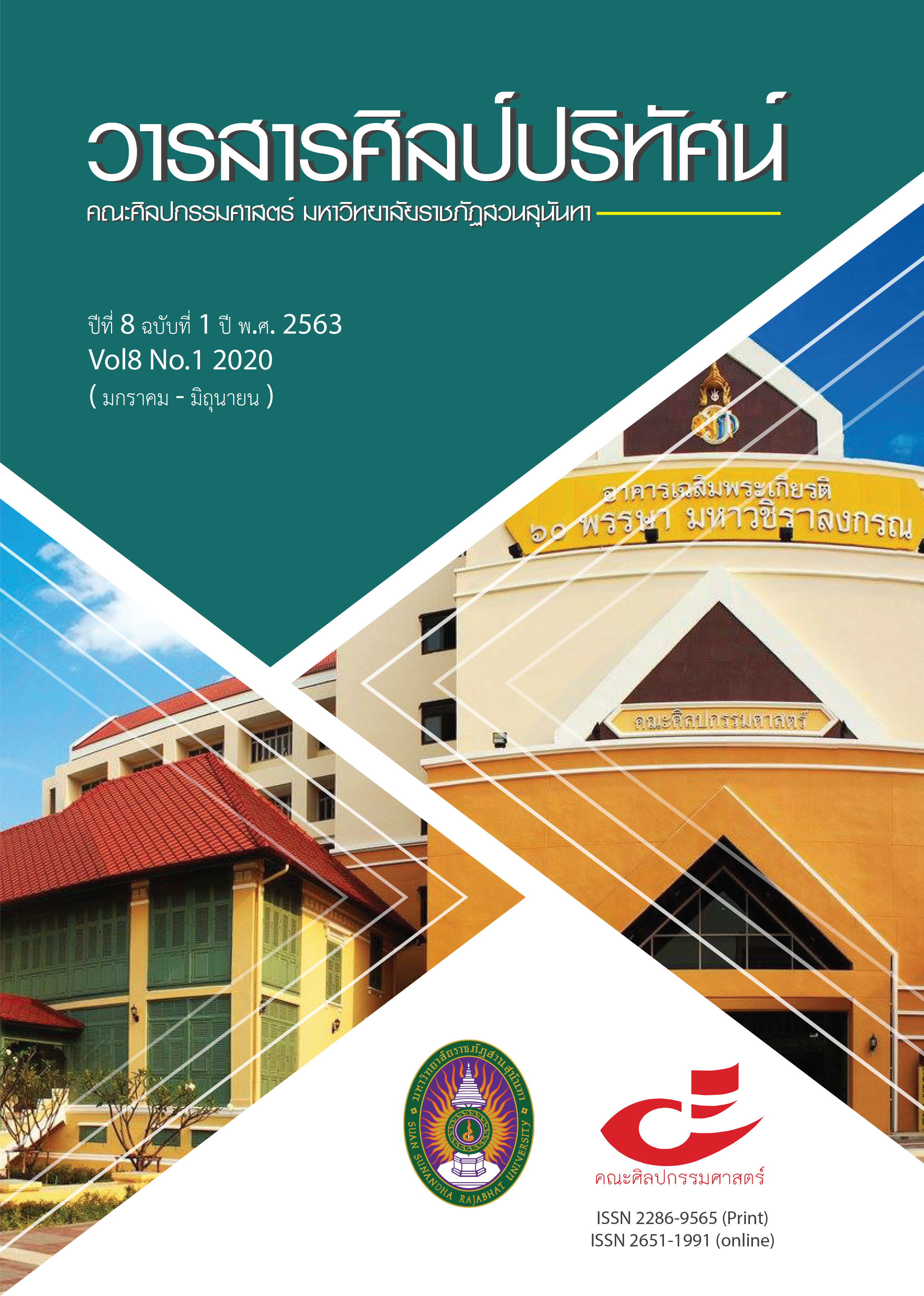Eighty-Nine Vessantara Cloths of Isan Painting of the Ninth King of the Chakri Dynasty
Main Article Content
Abstract
The Vessantara cloth, known as “Pha-ved Cloth” is a cultural heritage of the northeastern (Isan) people, which the fabric paintings have reflected the notion and religious beliefs through the story of Vessantara Jataka as a record of the paintings of the writers in the support to the Vessantara preaching and ritual ceremony in inviting Pra-ved into the city. The Pra-ved procession is a Buddhist ritual as a strategy to educate the Isan people through Buddhist doctrine and teachings containing the concepts of merit-making and giving alms, and educating the community where the Buddhism is the center of the mind. The objective of offering eighty-nine Pra-ved cloths is to create and preserve the Isan painting that is fading away over time due to changes in the livelihoods of the Isan people. The refurbishment of Pra-ved cloth is therefore aimed to bring the body of technical knowledge in contemporary art to develop the Pra-ved fabric painting that maintains the charms of the Isan painting process through the investigation of Isan painting and absorption of the learning experience of being a voluntary folk technician or painter in the northeastern temples, learning and practicing techniques and transfer process of the traditional way of folk craftsmen to understand and preserve the northeastern painting style. Regarding content creation process, the story of the royal activities committed by His Majesty King Bhumibol Adulyadej has been adopted as a creative model under this royal gratitude who is the Great Giver deserving a Buddhist worshiping in accordance with the researcher’s intention in creating to bring about the public interest in the cultural heritage preservation of Isan people as well as to integrate the prior knowledge and evolutionary methods to develop wisdom based on the contemporary art knowledge to outreach the community people through the Pra-ved merit-making ceremony.
Article Details
เนื้อหาและข้อมูลในบทความที่ลงตีพิมพ์ในวารสารศิลป์ปริทัศน์ ถือเป็นข้อคิดเห็นและความรับผิดชอบของผู้เขียนบทความโดยตรง ซึ่งกองบรรณาธิการวารสารไม่จำเป็นต้องเห็นด้วย หรือร่วมรับผิดชอบใดๆ
บทความ ข้อมูล เนื้อหา รูปภาพ ฯลฯ ที่ได้รับการตีพิมพ์ในวารสารศิลป์ปริทัศน์ถือเป็นลิขสิทธิ์ของวารสารศิลป์ปริทัศน์
References
ขวัช ปุณโณทก. (2530). ศิลาจารึกวัดแดนเมือง 2, ศิลาจารึกอีสานสมัยไทย-ลาว: ศึกษาทางด้านอักขรวิทยาและประวัติศาสตร์ อีสาน. กรุงเทพฯ: คุณพินอักษรกิจ.
จักรมนตรี ชนะพันธ์. (21 กุมภาพันธ์ พ.ศ.2550). บุญผะเหวดอีสาน : กับมหาทานบารมี. สืบค้นจาก https://www.silpa- mag.com/club/art-and-culture/article_6667
จารุณี อินเฉิดฉาย. (2545). พระบฎ: ภูมิปัญญาไทยในจิตรกรรมไทยประเพณี ศิลปากร, กรุงเพทฯ: เอ.พี.กราฟิค ดีไซน์และการ
พิมพ์ จำกัด.
ชวลิต อธิปัตยกุล. (2559). รายงานการวิจัย ฮูปแต้มในวัฒนธรรมลาว-ลาวล้านช้าง : ความโยงใยเชื่อมโยงสืบทอดกับฮูบแต้ม อีสาน ของประเทศไทย. อุดรธานี: เต้า-โล้.
ทรงวิทย์ พิมพะกรรณ์. (2560). ฮูปแต้ม มรดกวัฒนธรรมสองฝากฝัง. ใน มารศรี สอทิพย์ การสัมมนาวิชาการสานสัมพันธ์
วรรณกรรมไทย-ลาว ครั้งที่ 4. ขอนแก่น
พระครูวินัยธรมานพ ปาละพันธ์ (กนุตสี โล). (2553). สืบสานการเทศน์่มหาชาติ. กรุงเทพ ฯ : บริษัท เอดิสัน เพรสโพรศักส์ จำกัดไพโรจน์ สโมสร. (2532). จิตรกรรมฝาผนังอีสาน. กรุงเทพฯ: อัมรินทร์พริ้นต์กรุ๊ป จำกัด
รณภพ เตชะวงศ์. (2553). ความเหมือนที่แตกต่าง ใน นิยม วงศ์พงษ์ทำ, บทความวิชาการศิลปวัฒนธรรมลาว-ไทย: มรดกล้านช้าง 2. ขอนแก่น: โรงพิมพ์คลังนานาวิทยา
ศิริพันธุ์ ตาบเพ็ชร. (2541). ฮูปแต้มสิมอีสาน จังหวัดมหาสารคาม. เมืองโบราณ
สารานุกรมวัฒนธรรมไทย. (2542). ภาคอีสาน เล่ม 9. กรุงเทพฯ: มูลนิธิสารานุกรมวัฒนธรรมไทย ธนาคารไทยพานิชย์
สุมาลี เอกชนนิยม. (2548). ฮูปแต้มในสิมอีสาน งานศิลป์สองฝั่งโขง. กรุงเทพฯ: มติชน
สุรชัย จงจิตงาม. (2551). พระบฎวัดนาคตหลวง. วารสารเมืองโบราณ. 34(3), 1.
อภิวัชญา นาเลิง. (2558). การเปลี่ยนแปลงด้านรูปแบบผ้าผะเหวดอีสาน. วารสารวิถีสังคมมนุษย์. 3(2), 156-178


